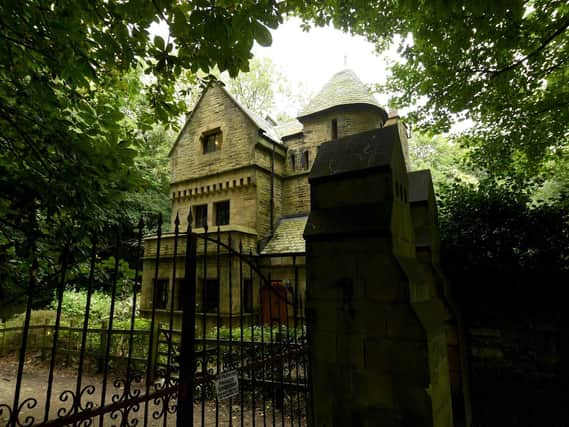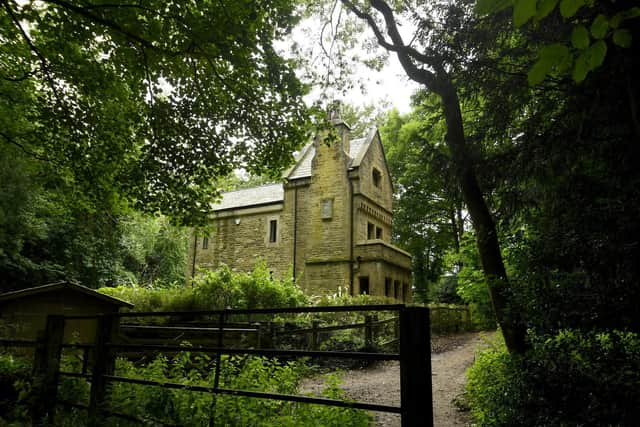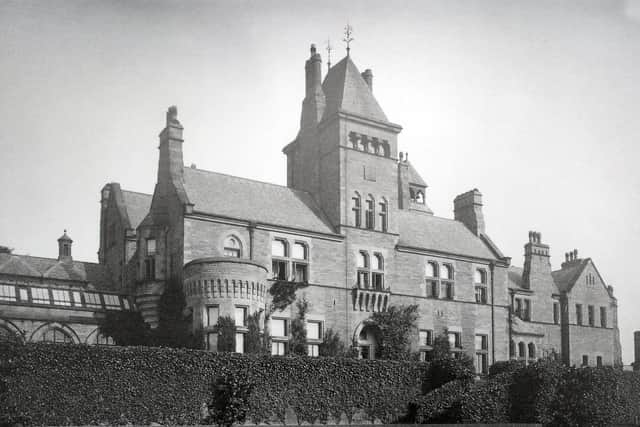The last surviving part of the Salt family's lost mansion is up for rent


North Lodge at Gilstead, near Bingley, is one of the last surviving remnants of Milner Field, the house built by Sir Titus Salt's son, Titus Jnr, overlooking the village of Saltaire and the family's wool empire in 1873.
The mansion was demolished in the 1950s but the last few decades of its existence are shrouded in mystery. It was even used as target practice by the Home Guard in World War Two, and was stripped of building materials that were then used to repair Salts Mill.
Advertisement
Hide AdAdvertisement
Hide AdAll that remains of the mansion are a mosaic floor and some brickwork buried in a woodland clearing, along with the sealed entrances to the cellars that once ran below the house.


North Lodge and South Lodge survived the demolition and the 'gothic' three-bedroom gatehouse is now available to rent for £1,300 per month through estate agents Linley and Simpson.
For 60 years, Milner Field was one of the most gilded houses of its age, hosting royal visitors and local dignitaries.
Yet in later years it became associated with tragedy and was even said to be cursed.
Advertisement
Hide AdAdvertisement
Hide AdTitus Salt Jnr commissioned the house in 1873, soon after he had married Catherine Crossley, a daughter of the Halifax carpet manufacturing family. The mansion was a fitting seat for one of Yorkshire's most powerful industrial dynasties and they raised their sons Gordon, Harold and Lawrence and daughter Isabel there, moving from their previous family home, Baildon Lodge, and demolishing the existing house on the Milner Field estate to accommodate their pleasure gardens, glasshouses, boating lake, model farm and carriage road to the mill.


The great house had an octagonal kitchen based on Glastonbury Abbey's, an orangery, a billiard room decorated with medieval court scenes, a croquet lawn and an 81ft domed conservatory full of exotic fruit.
The then-Prince of Wales, the future King Edward VII, visited as did Princess Beatrice, the youngest daughter of Queen Victoria.
Titus was the fifth and youngest son of Sir Titus, but he became more involved in the mill than his four brothers, and was also a noted philanthropist who donated to schools and hospitals. His interest in education led him to propose a new school of art and science for Saltaire, to be funded by public subscriptions and the sale of tickets to an exhibition marking Queen Victoria's Jubilee.
Advertisement
Hide AdAdvertisement
Hide AdIt was the financial pressure exerted by this campaign - the ticket revenue did not cover the cost of the new school - which led to the first tragedy to strike Milner Field when Sir Titus Jnr died in the smoking room in 1887, having been diagnosed with a heart condition two years before. He had earlier sent his apologies for being too unwell to chair a meeting about the exhibition plans.
By this point, the business was struggling - exports to America were affected by steep tariffs, and changing fashions meant there was less demand for wool. Badly-judged investments in mining and iron production in America exacerbated the financial difficulties. He had lived in the house for 18 years.
The Salts Mill empire and Milner Field passed into the hands of Sir James Roberts, a self-made wool baron from Haworth who began working in mills at the age of 11. He was initially successful in running the business, but the curse of Milner Field seemed to dog his family after they moved from their previous residence, The Knoll in Baildon.
He purchased the house from the widowed Catherine Salt, who eventually retired to Harrogate with her daughter Isabel.
Advertisement
Hide AdAdvertisement
Hide AdThree of his four sons died in just a 14-year period between 1898 and 1912; the eldest, William, of pneumonia aged 24, the second, Bertram, of a nervous illness aged 36 and the youngest, Jack, drowned while on holiday in Ireland as a child. The surviving son, Harry, was badly injured in World War One, and a nurse whom he had met in hospital and married died in the global influenza pandemic while pregnant.
Sir James's daughter Alice had eloped with medical student Norman Rutherford, the son of a local doctor in Shipley, in 1902 and married him in Scotland. He later became a decorated war hero, but in 1919 he shot and killed Alice's alleged lover, Major Miles Seaton. He was found guilty and sent to Broadmoor psychiatric hospital.
Bertram had four children at the time of his death, after which his brother Harry took over the management of the mill until he was conscripted into the army. He never returned to the business after his war injury and retired to a farm in Jersey. Bertram's eldest son, James Denby, inherited the business and baronetcy. Since 1911, the Roberts family have lived at Kilnsey Park in Wharfedale, which was once a sheep farm run by the monks of Fountains Abbey.
There were several unusual and premature deaths among the families who subsequently lived at Milner Field, and the house became difficult to sell or let as its ghoulish reputation grew.
Advertisement
Hide AdAdvertisement
Hide AdErnest Gates moved in in 1923, but lost his wife to illness just weeks later. Two years later, he died of blood poisoning after cutting his foot.
The final owner, Arthur Remington Hollins, took up residence in 1925 - both he and Gates had been managing directors at Salts Mill. His wife Anne died of pneumonia at 43 less than a year later, and three years later Arthur died on holiday from an irritation of the gallbladder.
The house was never occupied again after the early 1930s and was demolished quietly around 20 years later, having fallen into dereliction after two failed attempts to sell it at public auction. Only the lodges were saved and restored, and the model dairy farm remains operational.
Comment Guidelines
National World encourages reader discussion on our stories. User feedback, insights and back-and-forth exchanges add a rich layer of context to reporting. Please review our Community Guidelines before commenting.